| |
|
|
| |
Cicada numbers swell.
Tue 28th January, 2014
|
|
|
|
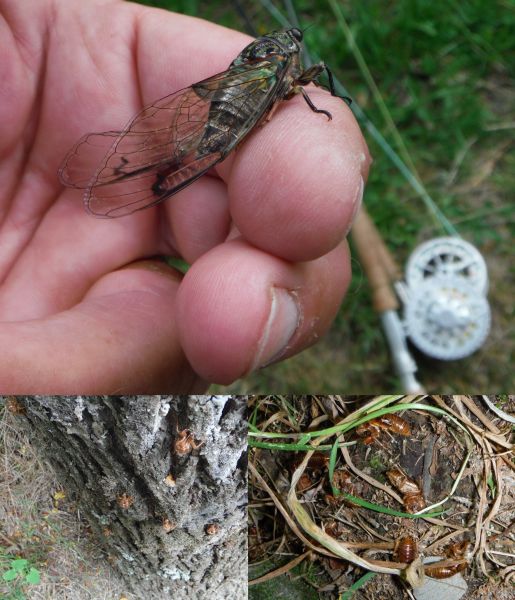 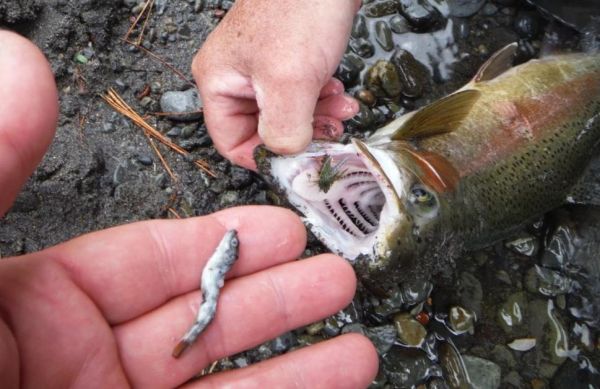 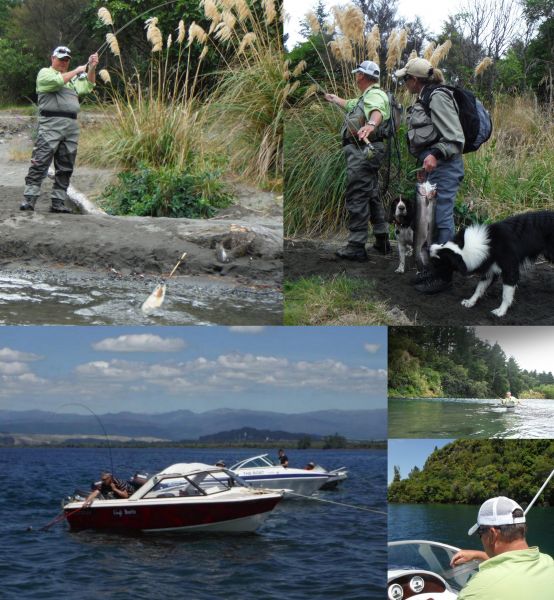
The lead up to the weekend saw cicada numbers swell ... virtually overnight! I've been on the river most days this past week and on Friday as I walked the middle river access tracks there were cicada husks everywhere, evidence that one of the best broods for years had continued to emerge.
On Saturday Gail and I had been invited to spend the day with Glenn and his wife Teresa out on the lake and every-time we got anywhere near the shore the noise was incredible.
I bumped into them again next morning as I made my way upriver and Glenn hooked up to his third fish while I stood there talking to him ... no prizes for guessing what he was using!
As he started to remove the Deer Hair cicada the rainbow gave up this baby trout ... browns aren't the only ones that enjoy a fish supper!
I was asked this week how come when there are so many cicadas around you don't you see loads of them floating downriver as you do ... with say ... mayfly ... during a hatch. The only explanation I can think of is that when they end up in the river they're quickly eaten ! You also have to remember that flies like caddis and mayfly are actually aquatic insects and their emergence takes place in the river.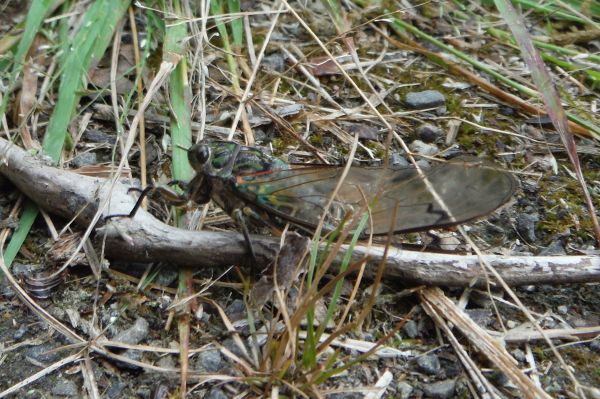
Although you'll hear and often see some of the cicadas that emerge from their burrows in amongst plant roots near the river, the cicada is a terrestrial and doesn't intentionally dive into the Tongariro.
Only a small percentage of them will accidentally fall into the river but when there are plenty of them around that's enough to get the trout interested.
Cicadas have large wings but they are hopeless aviators ... if you watch them they always look as if they're flying under the influence. On warm, breezy summer days it doesn't take much to push some of them off course and once they end up in the drink its unlikely they'd ever be able to break the rivers deadly grip.
Trout love cicadas and when they finally tune into them it can kick off weeks of exciting sport.
If you compare the body mass of a cicada with some of the tiny invertebrates that trout exist on during their time in the river its easy to understand why.
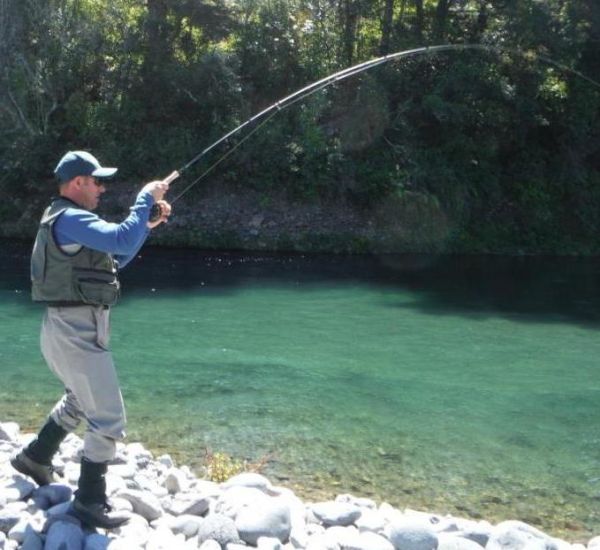
At first the fish hit them quite hard eager to take advantage of this large easy meal packed with calories. Just imagine how much energy they'd have to expend and how many mayfly or caddis they'd have to eat to obtain the same calorific intake.
But the more of these big insects they see floating downriver the less aggressive the takes seem to become. Its as if the fish realise that cicadas can't get away and they have plenty of time to grab them.
We don't get the massive plague-like cicada events that other countries experience but 2014 is going to be a good "cicada year" and we can look forward to some great action over the next few weeks.
Glenn's fish regurgitating that baby trout reminded me of an article I came across the other day at www.scotland.gov.uk all about the Ferox trout found in some of the lakes in Great Britain, part of which I've reproduced after the collage below.
As a mad keen young angler growing up in the UK, tales of these huge cannibalistic trout lurking in the depths of far away lakes used to really fire up the imagination. Back then it was universally accepted that Ferox trout were a separate species {Salmo ferox} but the authorities in Scotland have since broken ranks and declared they no longer believe this ... at least not as far as the Scottish ferox trout is concerned.
The brown trout {Salmo trutta} introduced into Lake Taupo in the late 19th century were from sea trout stock and I think I remember reading somewhere that these were originally obtained from the north of the British Isles.
Brown trout and sea trout are the same species { Salmo trutta }but environmental influences and genetics enable some young brown trout to develop a tolerance for saltwater which gives them access to a much greater source of food.
Like the brown trout of lake Taupo ferox trout are found in oligotrophic lakes in Ireland, Scotland, Wales and England and reading the article reminded me a little of our own browns because there are some similarities between the two ... for instance the bit about variation in shape, colouration and spot patterns.
I dug out some pics of browns I'd caught in the Tongariro over the last few years and as you can see they all look different ...
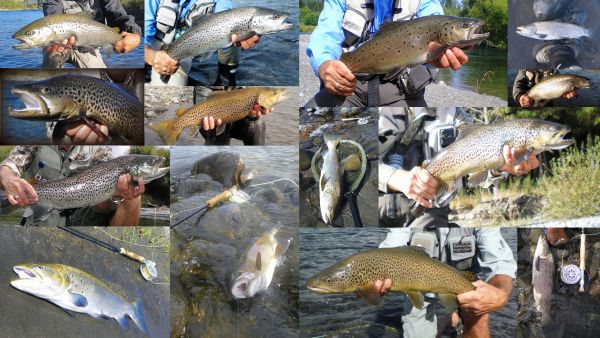
Ferox trout Salmo trutta; Linnaeus, 1758
Ferox trout is a widely used term for large predatory Brown trout. Although in the past, it was referred to as a separate species, Salmo ferox, this is no longer the case.
The Ferox life history is one of a number of life strategies adopted by one species, the brown trout, Salmo trutta.
Research into the genetics of Ferox trout, has shown them to be genetically distinct from other trout in some lochs (for example Lough Melvin, Ireland), but recent unpublished research from a variety of Scottish lochs has shown that this is not the case in all populations.
Data from Loch Rannoch samples, for example, have shown that a wide genetic variability exists within its Ferox population.
Ferox trout display a wide variety of shape, colouration and spot patterns. The condition of individual fish is also very variable and depends on factors such as age, season, whether it had spawned during the previous winter and possible parasite infestation.
The set of photographs below right, of Loch Rannoch Ferox trout, shows this wide range clearly.
Life History
After subsisting on invertebrates, some brown trout switch to a diet based mainly on fish. Brown trout that switch to piscivory find that the switch not only boosts their growth, but also adds to their longevity. The current UK rod caught record stands at 31lb 12oz (14.4 kg). The oldest recorded ferox trout in the UK is a fish of 23 years of age.
Documented evidence of growth potential has been obtained from recent research carried out in Loch Rannoch where increases of over 300 per cent bodyweight have been recorded.
Diet and Behaviour
Ferox trout have an unjustified reputation as cannibals, in part due to the misuse of the word cannibal to describe any trout that eats fish. Ferox have a marked preference for Arctic char. True cannibalism is probably less common than might be supposed - but in the absence of other prey fish, ferox will certainly prey on their own kind. Growth potential is influenced by the size spectrum of available prey.
Ferox trout are present in most if not all large Scottish lochs. They are highly prized by anglers and in recent years, angling pressure upon them has steadily increased.
The number of ferox trout within the trout population of a loch has always been a matter of conjecture. A catch and release project carried out in Loch Rannoch since 1994, where 70 ferox have been tagged and released to date, has provided some unique data.
Firstly, that if handled with great care, ferox trout can undoubtedly survive, and thrive, after catch and release. With nine recaptures to date, and several of these on more than one occasion, the indication is that there are not large numbers of ferox trout in the loch. The catch location data indicate that ferox trout are wide ranging, and do not hold specific territories.
Further research has been carried out in Loch Garry (Perthshire) to look in more depth, at the behaviour of Ferox trout. Using radio, acoustic and data storage tags, to look at spatial and diurnal movements.
The results so far, have verified observation made at Loch Rannoch with regards to territoriality.
During a study undertaken in 1999, two large ferox trout were observed over a three week period and moved throughout the loch during the hours of daylight, moving distances of up to 1 km in a matter of hours. Observation on one of the fish during the hours of darkness on two separate occasions showed it to move into shallower water and become less active in darkness ... more at www.scotland.gov.uk
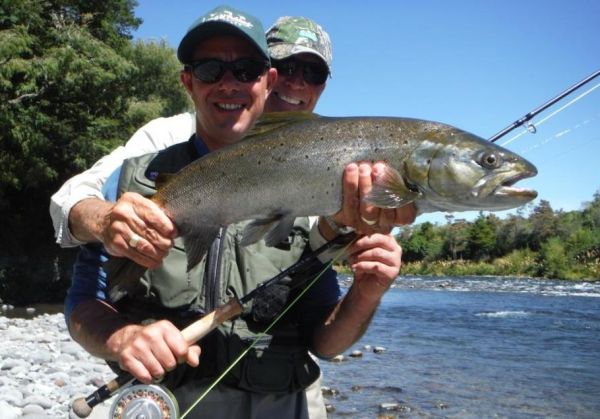
Back on the Tongariro this brown couldn't resist the cicada fly that Maria Agathos drifted over it.
If you're wondering why Maria hadn't shaved ... its because that's her husband Jerry ... Maria was behind the camera.
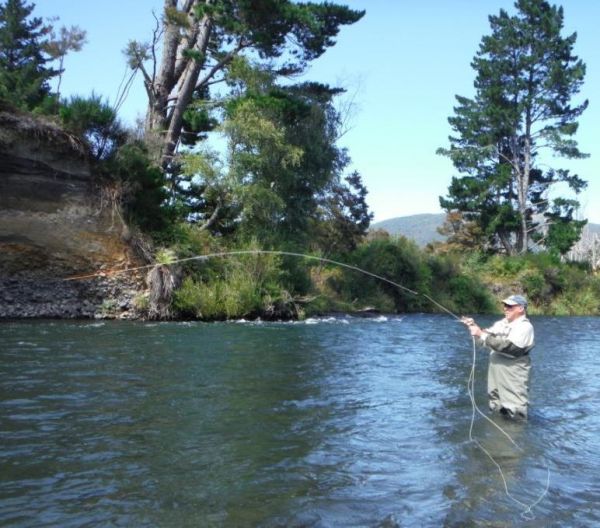
The cooler fresh south easterlies have put anglers off today and the river is pretty quiet ... not that its been that busy recently.
Its still carrying a little bit of color after Sundays heavy rain and this short blip in the weather has temporarily shut a lot of the cicadas up.
Looks like its back to normal tomorrow with fine weather and lighter winds forecast for the rest of the week ... so that'll get em chirping again.
Don't forget Saturdays Recreational Release from the Poutu Intake scheduled between 9.00 am and 3.00 pm. This will affect the town stretches around 11.30 am.
Tight lines guys
Mike |
|
|
| Back to Top |
|
|
|
|
|
|
|